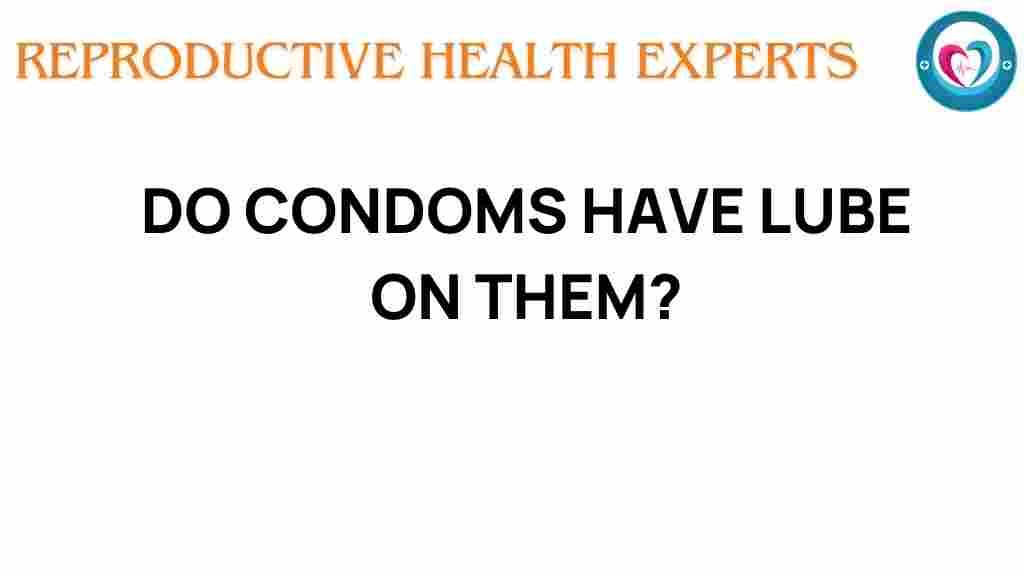Do Condoms Have Lube? Uncovering the Truth Behind Protection
When it comes to sexual health, understanding the tools available for safe intimacy is crucial. One common question that arises is whether condoms come with lubricant. This article dives deep into the relationship between condoms and lubricant, addressing common myths and providing essential education for safe sexual practices. Whether you’re a seasoned user or new to the world of protection, this guide will illuminate the facts.
Understanding Condoms and Lubrication
Condoms are one of the most widely used forms of protection during sexual intercourse. They provide a barrier that reduces the risk of sexually transmitted infections (STIs) and unintended pregnancies. Lubricants, on the other hand, enhance pleasure and reduce friction during intimacy. But do condoms come pre-lubricated? The answer is more complex than a simple yes or no.
Types of Condoms
There are various types of condoms available on the market, and their characteristics can vary significantly:
- Latex condoms: The most common type, effective against STIs and pregnancy.
- Polyurethane condoms: Suitable for those with latex allergies, offering similar protection.
- Polyisoprene condoms: Another latex alternative, soft and stretchy, providing comfort.
- Natural membrane condoms: Made from lambskin, effective for pregnancy prevention but do not protect against STIs.
Do Condoms Come Pre-Lubricated?
Many condoms are indeed pre-lubricated, which means they have a thin layer of lubricant applied to their surface. This lubrication helps to:
- Reduce friction during intercourse.
- Enhance comfort for both partners.
- Lower the chances of the condom breaking.
However, not all condoms come lubricated. Some brands offer unlubricated options for those who prefer to apply their own lubricant. It’s essential to read the packaging to determine whether the condom you choose includes lubrication.
The Importance of Lubrication
Using lubricant with condoms is beneficial for several reasons:
- Enhanced pleasure: Lubricants can increase pleasure for both partners, making the experience more enjoyable.
- Reduced friction: Lubrication minimizes friction, which can help prevent condom breakage.
- Comfort: For individuals who experience dryness, lubrication can enhance comfort during sex.
Types of Lubricants
When selecting a lubricant to use with condoms, it’s important to choose the right type:
- Water-based lubricants: Safe to use with all condom types, easy to clean, and do not stain.
- Silicone-based lubricants: Long-lasting and great for water play but should be used with caution with some silicone toys.
- Oil-based lubricants: Not compatible with latex condoms as they can cause breakage. However, they are safe with polyurethane and polyisoprene condoms.
For more information on different types of lubricants and their uses, check out this comprehensive guide.
Debunking Myths About Condoms and Lubricant
Despite the widespread availability of condoms and lubricant, several myths persist. Let’s address some of the most common:
Myth 1: All Condoms Are Lubricated
As mentioned earlier, not all condoms come pre-lubricated. Always check the packaging to confirm.
Myth 2: Lubrication Isn’t Necessary
While some individuals may not feel the need for lubricant, it can significantly enhance comfort and reduce the risk of breakage. It is always recommended to use a suitable lubricant with condoms.
Myth 3: Any Lubricant Works with Condoms
Using the wrong lubricant can compromise the integrity of the condom. Always opt for water-based or silicone-based lubricants when using latex condoms.
Myth 4: Lubricants Increase the Risk of STIs
On the contrary, lubricants can help reduce friction, which may lower the risk of condom breakage, thus enhancing safety during intimate activities.
Step-by-Step Guide to Using Condoms and Lubricants
Using condoms and lubricants effectively is essential for sexual health. Here’s a simple guide:
- Choose the right condom: Select a condom that suits your needs and check for lubrication.
- Apply lubricant: If the condom is unlubricated or if you prefer additional lubrication, apply a water-based or silicone-based lubricant to the outside of the condom.
- Check the expiration date: Always verify that the condom is not expired and the packaging is intact.
- Put on the condom: Pinch the tip of the condom to leave space for semen, then roll it down the shaft of the penis. Ensure it fits snugly.
- Engage in intimacy: Enjoy safe intimacy, being mindful of the use of additional lubricant if needed.
- Post-intimacy care: After intercourse, hold the base of the condom while withdrawing to prevent spillage. Dispose of the condom properly in the trash.
Troubleshooting Common Issues
Even with proper use, issues can arise. Here are some common problems and how to address them:
Condom Breakage
If a condom breaks during intercourse:
- Stop immediately and check for any signs of breakage.
- Consider emergency contraception if necessary.
- Get tested for STIs if you are at risk.
Allergic Reactions
Some individuals may experience irritation or allergic reactions to latex. If you notice any discomfort:
- Switch to non-latex condom options, such as polyurethane or polyisoprene.
- Consult a healthcare provider for personalized advice.
Dryness or Discomfort
If you experience dryness during intercourse:
- Use a suitable lubricant to alleviate discomfort.
- Consult a healthcare professional if dryness persists, as it may indicate underlying issues.
Conclusion
Understanding the relationship between condoms and lubricant is vital for maintaining sexual health and safety. While many condoms are pre-lubricated, using additional lubricant can enhance comfort and pleasure while minimizing the risk of breakage. It’s essential to dispel myths surrounding condoms and lubrication to foster an environment of education and safety.
By prioritizing protection and communication with your partner, you can enjoy intimate moments with confidence. Always choose the right type of condom and lubricant for your needs, and don’t hesitate to seek guidance if you encounter challenges. Remember, safety and intimacy go hand in hand, and being informed is the first step towards responsible sexual health.
For further reading on sexual health and safety, visit this resource.
This article is in the category Prevention and created by ReproductiveHealthExperts Team

2 thoughts on “Do Condoms Have Lube? Uncovering the Truth Behind Protection”